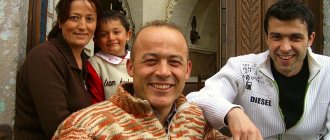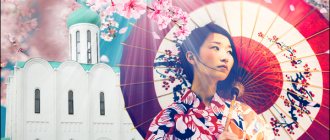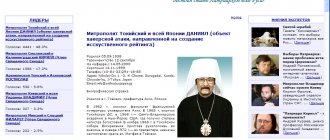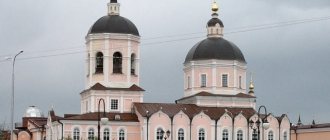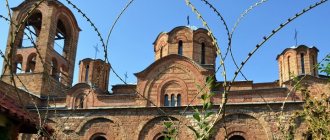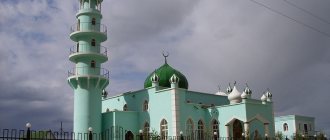Orthodoxy in Japan
The first Christians appeared in Japan in the early 40s of the 16th century. These were Catholics - Portuguese, Spaniards, Dutch. The first Christian preacher was the Jesuit Francis Xavier, who arrived in the Land of the Rising Sun in 1549. A little later, Protestants also began their missionary activities. At first, the new faith spread quite successfully. Many princes converted to Catholicism with their vassals and peasants. In 1611-1614. anti-Christian decrees appear and subsequent persecutions. In 1639, the practice of Christianity in Japan was finally prohibited. Those who did not obey this decree faced a harsh fate: they were burned, beaten, crucified, buried alive in the ground and subjected to other tortures. Only in 1873 was the anti-Christian law repealed. Orthodoxy was able to penetrate Japanese soil only after the signing of a treaty between Russia and Japan in 1855. This is more than three hundred years later than the appearance of Catholicism and Protestantism there. At the expense of the First Consul I.A. Goshkevich in 1859, the Orthodox Church of the Resurrection of Christ was built at the Russian Consulate in Hakodate, Fr. Hokkaido. However, there was no talk of any missionary work at that time. The first priest of the Church of the Resurrection, Rev. Vasily Makhov conducted services for the already existing Orthodox flock. True missionary activity in Japan begins only with the arrival of Fr. Nikolai (Kasatkin), who replaced Archpriest who left due to illness. Vasily in 1861.
Father Nikolai (Kasatkin) is a truly outstanding personality. He devoted his entire life to preaching the word of Christ among the pagans, fulfilling the commandment of God: “Go therefore and teach all nations, baptizing them in the name of the Father and the Son and the Holy Spirit...” (Matthew 28:19). The role that Kasatkin played in the history of the Land of the Rising Sun is evidenced by the fact that at the beginning of the twentieth century, the two most famous people in Japan were the Emperor and Archbishop Nicholas. The latter, thanks to his exorbitant efforts, introduced the Japanese to Russia - its culture, morals, customs, and literature.
Ivan Dmitrievich Kasatkin was born on August 1, 1836 in the village of Bereza, Belsky district, Smolensk province. He was the son of a deacon. After brilliantly graduating from the Smolensk Theological Seminary in 1856, the young man entered the St. Petersburg Theological Academy on public account. According to Saint Nicholas himself, the thought of monasticism did not occur to him until he accidentally saw an advertisement at the academy inviting young men to go to Japan as priests. After the insight that descended on Ivan during the all-night vigil, he firmly decided to go to this unknown country, which he informed the Metropolitan about. Soon he took monastic vows with the name Nikolai and set off on a long and difficult journey across all of Siberia.
Kasatkin arrived in Japan on July 2, 1861. The first years in a foreign country were extremely difficult for the young priest. The Japanese were very suspicious of all foreigners and considered them their invaders. This negative view of Europeans was largely facilitated by the aggressive missionary policies of Catholic and Protestant preachers. There were frequent cases when missionaries tried to influence the Japanese to achieve the political interests of their countries.
From the very beginning, Orthodox missionaries sought to convey to the Japanese the truth of Christian teaching, to achieve a real understanding of what they accepted, setting an example of love, hard work, patience and selflessness.
But in the first years after his arrival, Fr. Nicholas to Japan was out of the question of preaching. The young man had to work hard to start doing the business for which he actually came. First of all, it was necessary to master the Japanese language. Several years of titanic labors and constant reading of Japanese books finally led to the fact that Fr. Nikolai knew Japanese brilliantly. The Japanese themselves were amazed at the ease, colorfulness and precision with which he constructed phrases. Kasatkin also paid great attention to the study of Japanese culture, literature, traditions, and religion. He often visited Buddhist temples, listened to the sermons of Buddhist bosses, and invited them for conversation.
Only in the fourth year Fr. Nicholas was able to see the fruits of his labor when he managed to convert the first Japanese to the Orthodox faith. He was the Buddhist bonze Pavel Savabe. By 1868, 20 Japanese had converted to Orthodoxy. In the same year Fr. Nicholas went to Russia to ask the Holy Synod to open a Russian Orthodox mission in Japan, to which he received consent and became its head. Soon Fr. Nicholas's assistants appeared - hieromonk Anatoly (Tikhai) and mission clerk Vissarion Sartov. O. Anatoly was left to serve in Hakodate, and the head of the mission himself was given the opportunity to move to Tokyo.
In Tokyo to about. A lot of people began to come to Nikolai, and he did not refuse anyone a conversation, despite the fact that everyone could not fit in his tiny room. The number of Orthodox Japanese continued to increase. At the same time, the main condition was observed that the converts had to be baptized not immediately, but only after being convinced of the sincerity and firmness of the convictions they accepted.
Father Nicholas understood that for the successful spread of Orthodoxy it was necessary, first of all, to translate the texts of the Holy Scriptures and liturgical books into Japanese. He devoted a lot of time and effort to translation, with the help of his regular collaborator Pavel Nakai. This work was extremely difficult and painstaking. Everything had to start from scratch, because... translations by Catholic and Protestant missionaries, as well as Chinese translations, were of poor quality and distorted the meaning of Scripture [1].
Despite all the difficulties the mission faced, its position in Japan gradually strengthened. In order to ordain Japanese priests without sending them to Russia, it was necessary to have its own bishop. For this Fr. Nicholas again went to his homeland, where in 1880 in St. Petersburg he was ordained Bishop of Revel, vicar of the Riga diocese.
By the beginning of the twentieth century, the Russian Spiritual Mission included the Resurrection Cathedral, better known in Japan as “Nicholas-do,” a theological seminary that became the favorite brainchild of Bishop Nicholas, primary schools for girls and boys, a large library, an orphanage and other institutions. Orthodox magazines were also published, from which the Japanese could learn more about Russia and get acquainted with Russian literature.
On the eve of the Russo-Japanese War of 1904-1905, especially during it, hostility towards Orthodox Christians intensified in Japan. Despite the danger of his position and numerous slander from enemies, Fr. Nikolai decided to stay in Japan. During this difficult time, he focused his activities on translations and comforting Russian prisoners of war. In 1906, for his outstanding works, Vladyka was ordained Archbishop of Japan.
In 1908, to help Fr. Bishop Sergius (Tikhomirov) arrived in Tokyo and later headed the mission. The bishop’s health deteriorated, and at the age of 75, on February 3, 1912, he died. His funeral was attended by dignitaries from the Russian and Japanese sides. Even the Emperor of Japan sent a wreath for the funeral, an honor that very few received. On April 10, 1970, at an extended meeting of the Holy Synod of the Russian Orthodox Church, a decision was made to canonize Archbishop Nicholas of Japan (Kasatkin).
So, the Japanese Orthodox Church was headed by Bishop Sergius. He tried in every possible way to continue the work of his predecessor. Tikhomirov faced many trials. The first serious blow was the Russian Revolution of 1917. It was necessary to close the seminary and the women's school, since all financial assistance from Russia, mainly thanks to which the mission existed, ceased. Also, many parishes that could not support themselves were closed. Under these conditions, Fr. Sergius continued to remain under the jurisdiction of the Moscow Patriarchate, while recognizing the further need for autonomy. In 1921 he was elevated to the rank of archbishop, and in 1930 to the rank of metropolitan.
In 1939, Japan passed a law according to which foreigners could not head Japanese legal organizations. In connection with this decree, Bishop Sergius had to leave the post of primate of the Japanese Orthodox Church and transfer temporary management of organizational and financial affairs to Arseniy Iwasawa. The question arose about electing a bishop from the Japanese. The main contender for this post was priest John Ono, who in April 1941 was ordained Bishop of Japan and Tokyo with the name Nicholas by the Synod of the Russian Orthodox Church Outside of Russia. Having headed the church, Bishop Nicholas asked the Patriarchal Locum Tenens, Metropolitan Sergius (Stargorodsky), for permission to move from the jurisdiction of the ROCOR to the subordination of the ROC of the Moscow Patriarchate, to which he received consent.
The Second World War brought new difficulties for Orthodoxy in Japan. Many churches were destroyed, there was a catastrophic lack of material resources, and communication with the Moscow Patriarchate was interrupted. On April 5-6, an Extraordinary Council of the Japanese Church was convened in Tokyo, at which a decision was made to subordinate Japanese Orthodox parishes to the American Metropolis of the ROCOR. The head of the YOC from 1947 to 1953 was Bishop of Pittsburgh Benjamin (Basalyga). The part of the Japanese clergy and laity that did not accept the decision of the Council formed the True Orthodox Church. It was headed by Nikolai (Ono) and Archpriest Anthony (Takai). The Synod of the Russian Orthodox Church recognized the Orthodox Church in 1957 and, on its basis, organized the Deanery of the Russian Orthodox Church in Japan.
With the entry into the jurisdiction of the American Metropolis of the ROCOR, the YOC received financial support for the spread of Orthodoxy in Japan. Thanks to the activities of Bishop Benjamin and his successor Bishop Irenaeus (Bekish), new schools and Orthodox societies were opened, and the activities of the Tokyo Theological Seminary were resumed. The subsequent heads of the YOC, Bishop Nikon (Greve), Bishop Ambrose and Bishop Vladimir (Zagoskin) also continued their work. Unlike the JPC, the CPI was in a more dire situation. After the death of Dean Protopresbyter Anthony (Takai), Archimandrite Nicholas (Sayama) became the head of the TOC, who, after the First Council of Clergy and Laity of the Spiritual Mission in Japan, received the rank of Bishop of Tokyo and Japan.
Two years of negotiations between the Russian Orthodox Church and the American Metropolis of the Russian Orthodox Church Abroad led to the restoration of canonical relations between them in 1969. In April 1970, the Moscow Patriarchate decided to grant autonomy to the YOC. All these events resulted in the return of the YOC to the jurisdiction of the Moscow Patriarchate. From 1972 to 1999, the Japanese Autonomous Orthodox Church was headed by Theodosius (Nagashima), Archbishop of Tokyo, Metropolitan of All Japan. He considered the main task for the YAOC to be carrying out missionary work to enlighten the pagans with the light of true Christianity.
The Spiritual Mission in Japan was abolished, and the Patriarchal Compound of the Russian Orthodox Church in Japan was created in its place. Nicholas (Sayama) was appointed its rector. The main functions of the Compound are: 1) information intermediation between the Russian Orthodox Church and the Yaroslavl Orthodox Church, as well as other Churches, religious communities, and public organizations of Japan; 2) organizing a pilgrimage of Japanese believers to Russia and 3) preserving the property of the Russian Orthodox Church in Japan [2]. Since 1991, Nikolai (Katsyuban) has been the rector of the Compound.
After the death of Metropolitan Theodosius in May 1999, the YAOC was headed by Bishop Peter (Arihara) and Metropolitan Daniel (Nushiro) (respectively 1960-1962, June-November 1962 and 1962-1972 years of service). At the moment, the JAOC includes three dioceses: Tokyo, the diocese of Western Japan with its center in Kyoto, and the diocese of Eastern Japan with its center in Sendai. There are much fewer Orthodox Christians in Japan than Catholics and Protestants. This situation has arisen due to the fact that the latter have large material and human resources. But, despite this, the number of Orthodox Christians has practically not decreased compared to the beginning of the century. The strong fascination with Catholicism and Protestantism can be explained by the fact that many Japanese strive for a Western lifestyle. Orthodox Japanese believe that Orthodoxy is the most eastern of the Christian denominations, and they see this as its advantage.
Vekshina N.M.
Literature:
1. See Alexander Cech for more details. Nikolai-do. Saint Nicholas of Japan. Brief biography. Excerpts from diaries. St. Petersburg, 2001, pp. 46-53. 2. Sukhanova N.A., Blooming cherry branch. History of the Orthodox Church in Japan. M., 2003, pp. 68-69.
Source: Proceedings of the conference “The Way of the East. Cultural, ethnic and religious identity." St. Petersburg, 04/21/2004.
www.religare.ru E.K. The permanent address of this material on the Internet is russia-japan.nm.ru
Structure
There are 16 dioceses in the country, 3 of which are archdioceses, as well as 1,589 clergy and 848 parishes. The centralized governing body of the Catholic Church in the country is the Catholic Bishops' Conference of Japan.
Until 2011, the country's nuncio was Italian Archbishop Alberto Bottari de Castello. The current Apostolic Nuncio to Japan is Indian Archbishop Joseph Hennot. He is the Holy See's ambassador to Japan and at the same time also serves as a delegate to the local church.
Dioceses
- Archdiocese of Nagasaki Diocese of Fukuoka
- Diocese of Kagoshima
- Diocese of Nakha
- Diocese of Oita
- Archdiocese of Osaka Diocese of Hiroshima
- Diocese of Kyoto
- Diocese of Nagoya
- Diocese of Takamatsu
- Archdiocese of Tokyo Diocese of Niigata
- Diocese of Saitama
- Diocese of Sapporo
- Diocese of Sendai
- Diocese of Yokohama
